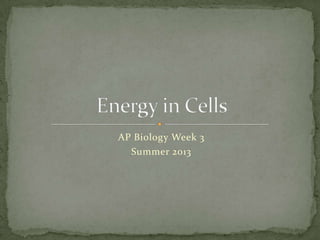
AP Biology Week 3 Cell Processes
- 1. AP Biology Week 3 Summer 2013
- 2. For each question, circle one of the words in the (parentheses) to make the sentence true. 1. A cell in a (hypertonic/hypotonic/isotonic) solution experiences osmosis of water into the cell. 2. The plasma membrane is selectively permeable, which means (ions/glucose/dissolved gases) can pass directly through, while (ions/dissolved gases/water) must be transported through proteins. 3. (Active transport/passive transport/facilitated diffusion) requires the use of energy, which in the cell is found in the energy-carrying molecule (ATP/ADP/glucose)
- 3. Besides the cell membrane or plasma membrane, all cells share the following parts: Cytoplasm, a jelly-like liquid interior Ribosomes, little protein-making factories DNA, which carries genetic instructions Our own cells are complex, with many internal membrane This splits all known cells into two groups: simple prokaryotes and complex eukaryotes
- 5. Plants, animals, fungi, and protists are eukaryotes All eukaryotes have membrane- bound organelles—tiny organs that do different jobs in the cell. Many organelles are involved in protein production, our topic next week. Organelle membranes are also phospholipid bilayers, often pinched off from the cell membrane itself.
- 6. The two energy-producing organelles in the cell. Mitochondria are found in all eukaryotic cells: animals, plants, and protists. Chloroplasts are found only in plants and some algae. They perform photosynthesis.
- 7. Mark the word or phrase with either (P) PHOTOSYNTHESIS, (C) CELL RESPIRATION (N) NEITHER, (B) BOTH • Produces ATP • Uses ATP • Occurs in mitochondria • Occurs in chloroplasts • Consumes oxygen • Consumes carbon dioxide • Consumes nitrogen • Occurs in plants • Occurs in animals • Requires enzymes • Produces glucose • Involves “fixing” carbon
- 8. Cellular respiration turns glucose into ATP energy The first stage, glycolysis, does not require mitochondria. It happens in the cytoplasm. In glycolysis, the six-carbon sugar glucose is split into two three-carbon pyruvate. A little bit of ATP and NADH are produced (energy!!)
- 9. Pyruvates still have some energy left. In your cells, they normally go into the mitochondria and get broken down. But if your cell: Has no mitochondria (because it’s a bacterium) Has no oxygen to use in mitochondria Then it will undergo a further step after glycolysis called fermentation, which breaks down pyruvate a little bit. “Anaerobic” = without oxygen. “Aerobic” = with oxygen.
- 10. Lactic Acid Fermentation Occurs in your muscles Happens AFTER glycolysis Cells “run out” of oxygen during difficult exercise Creates lactate molecules Produces sore muscles Occurs in yeast Happens AFTER glycolysis Cells are placed in an anaerobic environment, such as a vat of sugar with no air Creates ethanol Produces beer Alcoholic Fermentation
- 11. In eukaryotic cells, in the presence of oxygen, pyruvate normally enters the mitochondrion. There, it is broken down by a complex series of reactions known as the Krebs Cycle or the citric acid cycle. This cycle breaks apart carbon bonds, producing carbon dioxide and NADH/FADH2.
- 12. NADH and FADH2 are too temporary for proper energy use in the cell, so they are converted into ATP The process passes electrons down an electron transport chain that ends in ATP synthase. The electrons are built up on either side of the mitochondrial membrane so that there is a diffusion gradient.
- 13. Notice the order: electron transport chain, then calvin cycle Here the order is: glycolysis, krebs cycle, then electron transport
- 14. Make a quick Venn diagram comparing photosynthesis and cellular respiration. Some things to consider: What molecules are involved? Where do the reactions occur? How do the different reactions work (are they cycles, chains, etc.)? What organisms do they happen in? What are the reactants (what goes in)? What are the products (what comes out)?
